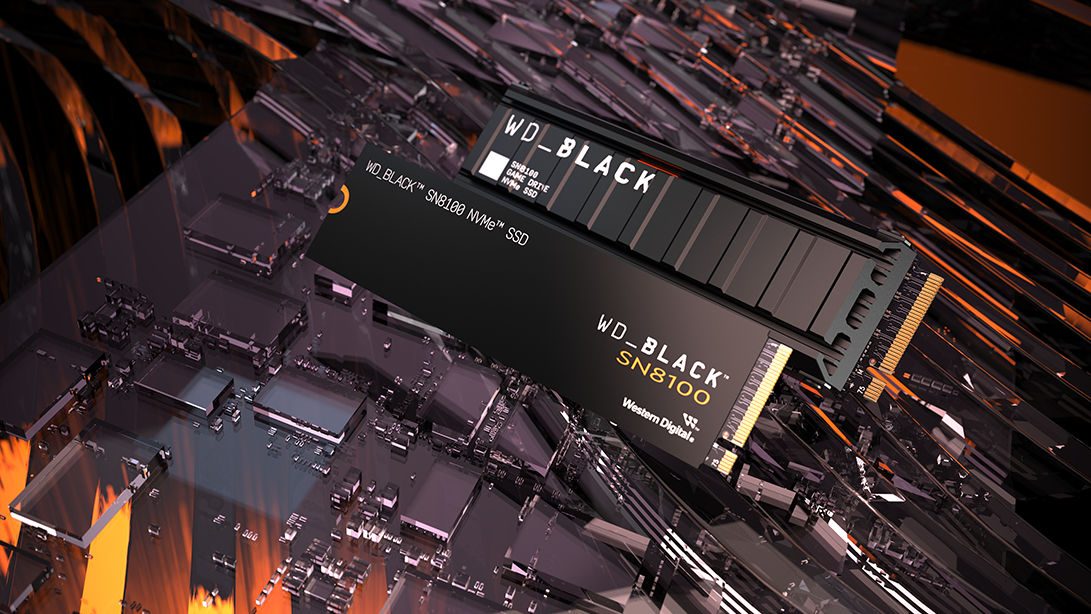Sandisk's new WD Black SN8100 claims to be the world's fastest NVMe SSD — 14,900MB/s read speeds and up to 8TB in capacity
Sandisk's newest NVMe promises unparalleled performance

Sandisk has just unveiled its brand new WD Black NVMe SSD, which it says is the world's fastest PCIe Gen 5.0 NVMe SSD on the market. The Sandisk WD Black SN8100 NVMe SSD promises speeds of up to 14,900MB/s and capacities of up to 8TB for gaming, content creation, and, of course, AI.
The company says the PCIe Gen 5.0 SSD is built for hardcore gamers. Not only is it rapid, but Sandisk says the Gen 5.0 model is 100% more power efficient than its PCIe Gen 4.0 SSD.
The new SN8100 also features Sandisk BiCS8 TLC 3D CBA NAND technology, which brings a lower profile and should improve thermal performance.
The spec listed sequential speeds for read and write are 14,900MB/s and 14,000MB/s, respectively, which would give our current best SSD for speed, the Crucial T705, a run for its money. Sandisk also promises 2,300,000 IOPS of random performance on the 2TB and 4TB models, all while averaging just 7W of power draw.
Name | WD SN8100 | Kingston Renegade G5 | Samsung 9100 Pro | Crucial T705 |
|---|---|---|---|---|
Flash Memory | BiCS8 TLC 3D CBA NAND (Likely 218-layer flash from Sandisk/Kioxia) | TLC (Likely 232-Layer NAND flash from Micron) | 236-Layer Samsung TLC NAND | 232-Layer Micron TLC NAND |
Form Factor | M.2 2280 | M.2 2280 | M.2 2280 | M.2 2280 |
Controller | N/A | SM2508 | Samsung Proprietary (Presto) | Phison E26 |
DRAM | Yes | Yes | Yes | Yes |
TBW (for 4TB variant) | 2,400TBW | 4,000TB | 2,400TB | 2,400TB |
Sequential Reads | 14.9 GB/s | 14.8 GB/s | 14.8 GB/s | 14.5 GB/s |
Sequential Writes | 14.0 GB/s | 14.0 GB/s | 13.4 GB/s | 12.7 GB/s |
Random Reads | 2,300K | 2,200K | 2,200K | 1,550K |
Random Writes | 2,300K | 2,200K | 2,600K | 1,800K |
Available from Sandisk.com and the usual suite of retailers and online vendors, the SN8100 comes in 1TB ($179.99 U.S. MSRP), 2TB ($279.99 U.S. MSRP) and 4TB ($549.99 U.S. MSRP) capacities, and it's worth noting the 1TB version only gets you 11,000MB/s write speeds compared to the larger capacities.
Coming later this fall will be a heatsink version for each capacity costing $20 more, and the 8TB versions are expected to be available later this year. The heatsink version offers a new integrated, low-profile passive cooling design built from anodized aluminum and also features customizable RGB LED.
Naturally, whether the SN8100 stacks up to its touted performance figure remains to be seen, but we'll be sure to bring you our performance results in our full review.
Get Tom's Hardware's best news and in-depth reviews, straight to your inbox.
Follow Tom's Hardware on Google News to get our up-to-date news, analysis, and reviews in your feeds. Make sure to click the Follow button.

Stephen is Tom's Hardware's News Editor with almost a decade of industry experience covering technology, having worked at TechRadar, iMore, and even Apple over the years. He has covered the world of consumer tech from nearly every angle, including supply chain rumors, patents, and litigation, and more. When he's not at work, he loves reading about history and playing video games.
-
dwd999 I clicked their Notify Me option because I would prefer the heatsink version when it becomes available. I need it because I bought the Arctic Freezer III Pro cpu cooler which doesn't allow me to use my motherboard's m.2 cooler. Theoretically I can request that Arctic send me the low profile m.2 cooler that they offer for free. Or I could just buy one on Amazon for $6. But I would really prefer WD's own. Hopefully I won't have to wait too long.Reply -
JTWrenn When will we slow down on the speed and crank up that capacity? 4TB has been the max for too long. We need a two tier system like we used to have with most spinning drives at different speeds.Reply -
Aurn Reply
More endurance per capacity would also be goodJTWrenn said:When will we slow down on the speed and crank up that capacity? 4TB has been the max for too long. We need a two tier system like we used to have with most spinning drives at different speeds. -
thestryker Reply
Welcome to the world of M.2 this is basically never going to happen at a reasonable cost like it did with 2.5" drives. Increasing capacity generally means using the latest NAND and more packages of it. Double sided drives are also harder to cool so we see limited numbers of them. If client stuck with 2.5" drives we'd have already seen 16TB and 8TB probably wouldn't carry the premium it currently does.JTWrenn said:When will we slow down on the speed and crank up that capacity? 4TB has been the max for too long. We need a two tier system like we used to have with most spinning drives at different speeds. -
Aurn Reply
I don’t know a lot about it, but I wonder if U.2 might come to desktop PCs sometime ? I’ve always dreaded having to replace M.2 drives because you often need to remove the CPU cooler and graphics card, so maybe it would also be more convenientthestryker said:Welcome to the world of M.2 this is basically never going to happen at a reasonable cost like it did with 2.5" drives. Increasing capacity generally means using the latest NAND and more packages of it. Double sided drives are also harder to cool so we see limited numbers of them. If client stuck with 2.5" drives we'd have already seen 16TB and 8TB probably wouldn't carry the premium it currently does. -
thestryker Reply
Never going to happen unfortunately. Some desktop boards had U.2 connectors in the Z170-Z390 era, but as far as I'm aware nothing newer than that. HEDT/Workstation boards have had them (or SlimSAS) since X99 (AMD as well). The only option for U.2 for most client users is going to be adapters in M.2 or PCIe slots.Aurn said:I don’t know a lot about it, but I wonder if U.2 might come to desktop PCs sometime ? I’ve always dreaded having to replace M.2 drives because you often need to remove the CPU cooler and graphics card, so maybe it would also be more convenient
Of course this isn't necessarily a bad option as used enterprise drives tend to be reliable enough and much cheaper than client drives (downside being idle power consumption). -
Jame5 That's what M.2 to U.2 adapters are for these days. I use one to run my Optane drive.Reply
I have to admit I'm tired of all of the SSD announcements this year being "We are releasing new 8TB PCIe5.0 generation models!!!*" With the asterisk always being "8TB model coming at the end of 2024 or 2025".
Maybe wait for it to be ready before you try and sell it?